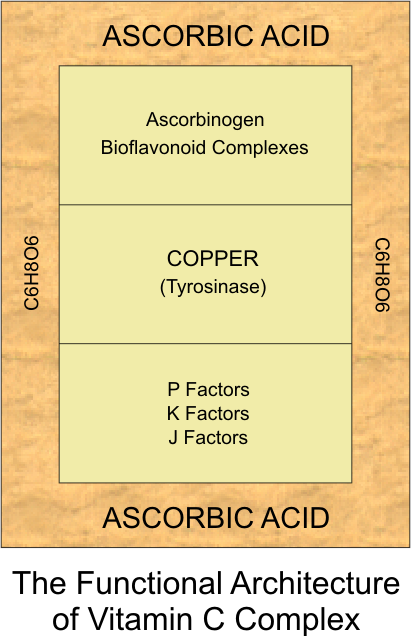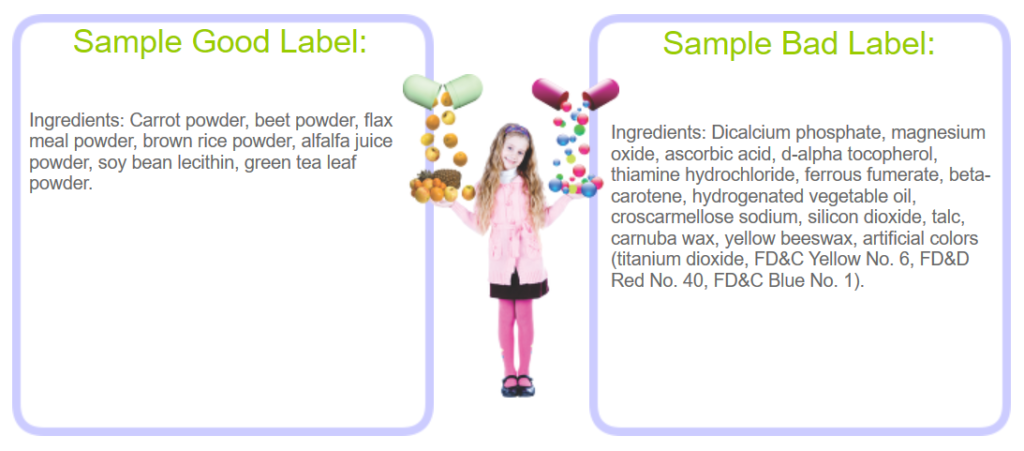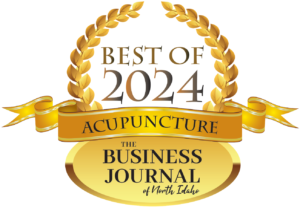Whole Food Supplements
Natural vs. Synthetic: Is There Really a Difference?

We are avid proponents of whole food vitamins (“supplements”). The purpose for taking supplements in the first place, is to supply the nutrients that are missing from our diets. If we’re not consuming the nutrients necessary for the various biological activities in the body, then those activities get compromised. Eventually, this results in the myriad of symptoms expressed on a daily basis.
The nutrients in our food supply are drastically reduced from what it was even 50 years ago. Our topsoil has eroded to alarmingly low levels, and our commercial produce is replanted in the same soil year after year with only 3 nutrients returned to the soil (NPK – nitrogen, phosphorus and potassium). Rarely is the soil composted, returning the diverse nutrients back to the soil to be taken up by the plants we eventually consume.
Couple that with the fact that we’re processing our foods to death, taking what little nutrients are in there after poor farming practices, time from farm to factory, etc., then killing it (in particular, the enzymes) so that we have shelf life and convenience. Because so much of our foods are so nutrient-devoid, we throw artificial vitamins into the packaged stuff, pretending to be adding something of value back to the food.
This is where vitamins come in. Because we realize the value of the diverse nutrients needed for the operation of our bodies, and we realize we are coming up short, we find, out of pure concern for our welfare, the necessity of taking pills that give us concentrated nutrients.
It only makes sense then, that those nutrients should come from foods.
However, that is rarely the case today. Most vitamins are synthetically produced; faux vitamins masquerading as being good for you. Unfortunately, the majority are just pure junk.
In the late 1920's and early 1930's, 3 distinguished men noted the effects of the modern commercialized foods on human health. They sought ways to counteract them. Dr. Royal Lee, a dentist, in 1929 formulated the first vitamin, "Catalyn". It was a concentrate of the most nutrient-dense plants he could find at the time. He was concerned about the micro-nutrients as well as the more well known macro (larger) nutrients. He understood that vitamins were always found in a complex, and never as single isolates, that the soil was the key to healthy nutrient-rich plants, and that proper care (for example, avoiding excess heat), was essential in developing a product that would replace the nutrients being robbed from our food supply. The laboratory vitamins later developed invariably were missing the vital co-factors that were necessary for the vitamin to work properly in the body. His concern was the quality and the expanse of the nutrients, not mega-doses of a single element (or fraction) of the vitamin complex.
Another physician, Dr. John Harvey Kellogg, ran a "sanitarium" (hospital) which employed the use of the natural remedies of the day. Also seeing the nutrient privation developing in this new processed food industry, he took the nutrients stripped from wheat and concentrated them into flakes and fed them to his patients. He was amazed at how quickly they recovered from a diversity of ailments. He began having his patients eat these wheat flakes every morning for breakfast, beginning the whole breakfast cereal movement. His brother, who developed the cereal business, found that corn was more palatable, and marketed "corn flakes" instead. Eventually, the company was sold and the vision of Dr. Kellogg lost in the process.
Rev. Sylvester Graham in the 1800's was also concerned about nutritional depletion, essentially doing the same thing with graham crackers as Dr. Kellogg did with wheat flakes. The original graham crackers were dry, rough and barely palatable. He would later add a little white flour to soften it, and took the whole concept to a bit eccentric level. But the essence of feeding a sick body the nutrients that were missing was a passion of his. Eventually, more white flour, white sugar and less wheat bran was added to it, an idea that he would have been abhorred to have seen. Today, it is more of a convenience cookie - certainly not the health food he created!
The whole food vitamin concept is that of taking the nutrients missing from our diet, concentrating them and putting them in a form we can easily take and absorb. Standard Process, the company whose whole food supplements we primarily advocate, takes plants, herbs or animal organs (such as liver), juices them, and through a low temperature vacuum extraction process, removes the water, then compresses the concentrate into tablets. What you get is food, concentrated to therapeutic potencies, pure and simple. The nutrients needed for bodily function are provided in a form most consumers prefer - a pill.
For more information about whole food supplements, you can visit the Standard Process website at www.standardprocess.com.
How to Read Vitamin Labels
The plethora of supplements on the market boggles the mind. Which is best? Which will give me the best for my dollars? The consumer is left to sort through unbelievable amounts of marketing designed to convince you to buy. The objective of the supplement company is money. If reducing supplement quality equates, for instance, to increased shelf life, which equates to a greater profit margin, they are willing to sacrifice quality for quantity of sales. The consumer is relegated to making a decision based on whose marketing is more effective, rather than how the product will actually work in their body. After all, supplements are taken to support function, not to support the vitamin industry!
Read Labels. Before your read any further, take out your vitamin supplements and have them next to you as you read on. The new nutritional disclosure labels actually make it more difficult to determine what are healthy ingredients and what are not. The old labels (still on many products), tell you more about what is really in the product. As a general rule of thumb, if you see vitamins listed in the ingredient section of the label, it is synthetic or fractionated, otherwise it would be listed as the food. Now on the new labeling, you have to look under the “Nutrition Facts” section as well (where it lists what percentage of the daily value of basic nutrients is contained in the product). Where the vitamins are listed, look where it displays parenthesis (for example: Vitamin A (as beta carotene)”. The word “as” generally denotes a synthetic or fractionated source, unless it sounds like a food. The ingredient label (since it is supposed to be food that you are eating) should sound like a food. So instead of the label saying, for example, “Vitamin C (as ascorbic acid)”, it should say “Vitamin C (from acerola cherries)”.
Forget the word “Natural”. It means nothing. This word has been grossly abused and no longer has any valuable meaning. Most supplements claim to be natural. Some say they are not synthetic. Few reference “fractionated”. The truth lies somewhere in-between.
Don’t be swayed by marketing propaganda. No supplement company is going to tell you their product is no good. If they did, they would soon be out of business. Their marketing is all geared towards making you believe it is the best product you will ever take! They will go to extreme cost to make you believe that. It is up to you to sort through what is marketing hype and what is really good. The intent of this article is to help you with that.
Be aware of fractionated vitamins. A “fractionated” vitamin means that the manufacturer altered the “natural” vitamin, generally to make it more shelf-stable. For instance, most Vitamin E is sold as “d-alpha tocopherol”. D-Alpha tocopherol and it’s many adulterations is not true Vitamin E. It is only a “fraction” of the Vitamin E complex. Vitamin E contains alpha, beta, gamma and delta tocopherols, “E-factors”, “F-factors”, selenium, xanthine and lipositols. D-alpha tocopherol is only one small fraction of the Vitamin E complex. As a result, it does not have the same effect in the body and can actually cause damage. Your vitamin label should list Vitamin E as “Vitamin E (as wheat germ oil)”, or have wheat germ oil in the ingredient section, and not labeled “Vitamin E (as d-alpha tocopherol)” or similar variation. Some will show Vitamin E as “Mixed tocopherols”. This simply means a little more was added back – any combination of alpha, beta or gamma tocopherols, but it is still missing all the other essential fractions.
Drug-like responses are all you can expect from synthetic or fractionated supplements. They will not heal or support bodily function. They will only help you initially to “feel better”. This is because the fractionated vitamin, containing only a fraction of the whole nutrient will search your tissues looking for the missing fractions, and then pull them out, in order to complete the complex. Initially, this will make you feel better, however, long term it will leave you more depleted than you were before you started taking the supplement. The vitamin supplement literally stripped your reserves! Examples of fractionated of synthetic vitamins include: d-alpha tocopherol, ascorbic acid, beta-carotene, thiamine mononitrate, cyanocobalamin, cholecalciferol, and many more. Basically, anything that doesn’t sound like a food is either synthetic or fractionated and should be avoided!

Let's Solve This Puzzle Together!
At Vital Health we help people find clarity regarding the root causes of their health challenges and provide step-by-step guidance on what to do, and when to do it, in order to restore health naturally.

